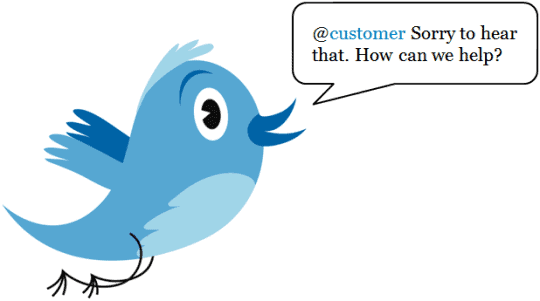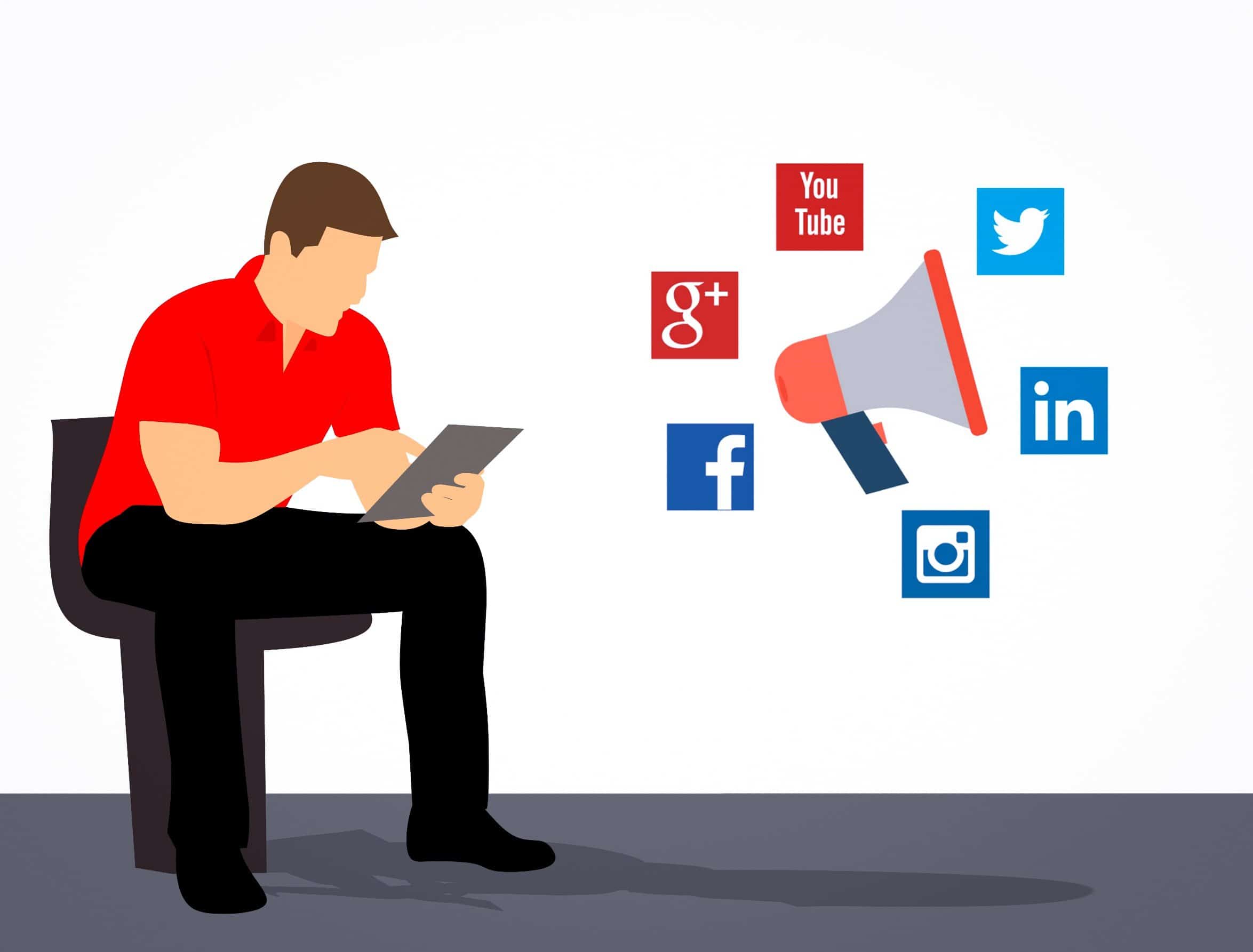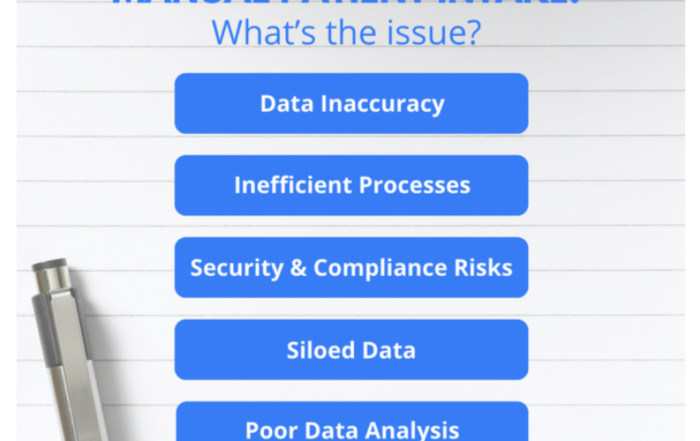So you’re on social media posting and snapping and tweeting and doing all of these great things. You stay ahead of most of your competition by creating engaging and informative content for your practice’s website, blog, and Facebook page. You post-holiday group photos of your office staff, send your patients a regular practice newsletter, and you’re even on Instagram!

But did you know that’s only the tip of the iceberg?
Below we’ll outline exactly:
- What social media customer service is
- Why it’s vital to both your online reputation and your medical practice
- Can’t-miss strategies to drive success
- Real-world examples of how it works
We’ll also touch on staying compliant with HIPPA throughout the process and the importance of diverting patient conversations offline when necessary.
“The Only Thing That Is Constant Is Change” – Heraclitus
Social media and how people use it is changing faster than most of us can keep up with. Social media technology is evolving at breakneck speed and consumers along with it. Just when you think you’ve got the pulse on what works and how to do it well, another wave of change comes crashing onto the shore forcing you to adapt yet again. Doctors who can effectively surf these breaks and stay ahead of the pack will ultimately be the ones to succeed.
Have you heard of ORM? It stands for online reputation management, and if you haven’t heard of it, welcome to the party. The reality is that your medical practice can no longer afford to ignore this crucial element of online marketing, and you need to be proactive in asking your patients for their feedback.
When online physician reviews first came on the scene, to say that most doctors and practice managers grossly disliked the idea would be an understatement. As we now know all too well, that unstoppable trend is now the norm, a fact of life for doctors, hospitals, and healthcare institutions. The fact is, Google loves reviews (plus they help to differentiate your practice on a local SEO level). Oh, and consumers (and patients) are enamored with them. No professional in any industry has gotten a free pass.
Before we dive into the nitty-gritty of how to leverage social customer care and ORM to your advantage, here’s a snapshot of why and how social media customer care has become the force it is today.
The Rise of Social Media Customer Service
We’re not going to preach to the choir here. But in case you’re not on the social media bandwagon just yet, here are a few stats to ponder as the gravy train goes by.

Social media has emerged as the go-to choice for consumers (and patients) who expect instantaneous 24-hour feedback, look for referrals from peers, share experiences (both raving and venting), and communicate with businesses.
- 90% of social media users have used social media to communicate with a brand.
In a 2016 report, Sprout Social confirmed that 90% of social media users had used social media to communicate with a brand. And when consumers’ concerns or complaints are not answered, more than 35% will publicly admonish the brand and one-third will switch to a competitor.
According to a recent survey conducted by Dimensional Research and Zendesk, 54% of consumers who shared a bad experience ended up sharing it more than five times, compared with 33% of those who shared a positive experience.
63% of customers expect businesses to offer customer service on social media. Companies that improve their customer experience from ‘average’ to ‘wow’ can see up to a 50% improvement in key measures (i.e., more satisfied customers, many of whom will share their positive experience online).
And people now prefer social media for customer care over other channels to the tune of:
- 34.5% of consumers prefer social media
- 24.7% prefer website/live chat
- 19.4% prefer email
- 16.1% still prefer to call in via phone
Social media customer service is growing rapidly. In fact, 81% of companies now use social media within their overall customer experience management program.
As more and more patients flock to social media to air their grievances, how can your practice turn potential negative customer service interactions into positives for future patients?
When it comes to patient interactions, it’s now vital for doctors and practice administrators to understand what being IN social media now means (hint: it’s not the same as being ON social) and to have a plan for managing it effectively. Mastering the art of social media customer care is a fundamental part of keeping your patients happy, resolving their problems or questions quickly, and boosting your credibility.
What Does It Mean To Be IN Social Media?

The most successful medical practices today aren’t just on social media – they have integrated social media into all aspects of managing and growing their practice including:
- Building their patient community (by reaching the right patients, at the right time, with the right message)
- Enhancing patient customer service (through messenger, responding in real-time to complaints and praise, and regularly interacting with patient)
- Maximizing their advertising dollars by using social media’s highly-targeted ad capabilities
A research study by Demi & Cooper reported that 41% of people affirmed that social media influenced their choice of a specific physician, hospital, or medical practice.
Thriving medical practices are the ones that engage with new, existing, and future patients well before they’ve walked through the door. They develop a committed, caring and professional image to current and potential patients online – whether on social platforms or online reputation management sites.
Practices use social customer care to improve patient experiences, leverage positive feedback, and mitigate negative reviews. How exactly are they doing this? And what can you do to proactively enhance your patient’s experience before they walk in for their first appointment?
Your Waiting Room: Where the Rubber Meets the Road

Let’s compare a couple of real-world scenarios to drive the point home. In both examples, we’re going to assume that the level of care received in the doctor’s office is excellent. The critical point being made here is that for patients, the total customer experience goes far beyond the care you provide, and often happens when your doors are closed for the day and before or after the care you have provided.
Donna’s First Appointment With Dr. Smith
Scenario 1: Making the appointment:
 Donna injured her ankle while playing ultimate frisbee at the park with her friends. She searches online for orthopedic practices in her area and finds Dr. Smith’s website. When she visits the practice website, she finds it cluttered, and it is difficult to find the contact form to make an appointment online. This frustrates Donna because as a super busy mom of two young children, she doesn’t have time to pick up the phone or spend precious minutes looking for an online form. After spending five minutes searching for the online appointment form, she finally finds it and sends it in a huff.
Donna injured her ankle while playing ultimate frisbee at the park with her friends. She searches online for orthopedic practices in her area and finds Dr. Smith’s website. When she visits the practice website, she finds it cluttered, and it is difficult to find the contact form to make an appointment online. This frustrates Donna because as a super busy mom of two young children, she doesn’t have time to pick up the phone or spend precious minutes looking for an online form. After spending five minutes searching for the online appointment form, she finally finds it and sends it in a huff.
Result: Donna has already had a negative experience before walking through the front door.
At the office:
Donna has kept the memory of her negative online appointment experience in the back of her mind as she enters the office for her appointment. Dr. Smith was in surgery since early morning and is running late for his appointments. However, none of this has been communicated to his patients.
After waiting for fifteen minutes, Donna is starting to fume. She left her house early to get to the appointment on time and didn’t have much to eat for breakfast. The waiting room is uncomfortable and completely barren except for a few outdated Readers’ Digest and People magazines. After twenty minutes, she is furious. She grabs her phone, takes a picture of the bland office magazines and posts them to her timeline saying: “@Dr. Smith’s practice: 20 minutes late, not a word to anyone, and nothing to read but this dribble…can anyone spell F-R-U-S-T-R-A-T-I-O-N?”
Ouch.
54% of consumers who shared a bad experience ended up sharing it more than 5 times, compared with 33% of those who shared a positive experience.
Scenario 2: A completely different experience
 When Donna visits Dr. Smith’s website, she is very impressed. The layout is professional and sleek, and there are visible buttons on every page to make an appointment in one click. The form also includes check boxes to receive notifications via Facebook and Twitter for any practice updates or important patient information. She opts-in and closes her laptop satisfied that she can move on to other things she needs to accomplish.
When Donna visits Dr. Smith’s website, she is very impressed. The layout is professional and sleek, and there are visible buttons on every page to make an appointment in one click. The form also includes check boxes to receive notifications via Facebook and Twitter for any practice updates or important patient information. She opts-in and closes her laptop satisfied that she can move on to other things she needs to accomplish.
As she is on the way to her appointment, Donna receives a notification on Twitter, Facebook, and via text message, that Dr. Smith has been in surgery all morning and is running late. She is slightly miffed but appreciates and is pleasantly surprised at having been given a heads up.
When she arrives at the office, she is amazed to find hot tea, coffee, and snacks laid out in the waiting room. She is thrilled because her stomach is rumbling after skipping breakfast.
There is also a notice in the waiting room explaining the delay, apologizing, and offering free WiFi service. Donna is so pleased she snaps a shot of the refreshments, the comfortable chairs, and the latest issue of Rolling Stone magazine on the coffee table and posts it to her timeline saying “Wow, now this is how a medical practice should treat its patients…thank you, Dr. Smith!”
Post-Treatment: The Patient Value Journey Continues
 As mentioned before, despite the very different patient experiences before seeing Dr. Smith, we’re going to assume that during her visit Donna received excellent, quality professional care. It goes without saying that the quality and level of care you provide is your number one customer service priority along the patient value journey. However, let’s take a look at what happens after leaving the examination room and in the days following Donna’s appointment.
As mentioned before, despite the very different patient experiences before seeing Dr. Smith, we’re going to assume that during her visit Donna received excellent, quality professional care. It goes without saying that the quality and level of care you provide is your number one customer service priority along the patient value journey. However, let’s take a look at what happens after leaving the examination room and in the days following Donna’s appointment.
Scenario 1:
While paying her bill at the reception, one of Dr. Smith’s nurses made an innocent comment seemingly related to Donna’s appearance, which Donna found a little offensive. She didn’t say anything at the time, but it made her uncomfortable.
A few days later, and needing to vent her concern, Donna went on to Yelp to write a review of Dr. Smith’s practice. She rated the care as very good, but the review was weak in other categories, leaving the overall score around average. Donna also shared her experience with the nurse in detail.
Dr. Smith’s practice does not have an internal feedback system or any follow up in place. They did not become aware of Donna’s displeasure until six months later when one of Dr. Smith’s admin staff was contacted by a friend who had seen the review. By that time, mitigating the damage and remedying the situation was nearly impossible.
Dr. Smith wondered how many potential patients had seen the review and if it might have influenced their decision to make an appointment…or not.
Scenario 2:
 Waiting for her in her inbox when she got home, was an email from Dr. Smith’s practice entitled “Tell us how we did.” Donna clicked the link which took her to a feedback form on the practice’s website. She filled it out, and in the comments box, mentioned how she had felt during her interaction with the nurse.
Waiting for her in her inbox when she got home, was an email from Dr. Smith’s practice entitled “Tell us how we did.” Donna clicked the link which took her to a feedback form on the practice’s website. She filled it out, and in the comments box, mentioned how she had felt during her interaction with the nurse.
Upon receiving the feedback form, the person in charge of practice operations, Joan, immediately received a notification on her phone. She read the feedback and knew she needed to respond immediately. She called Donna right away to get the full story. Donna explained what had happened and Joan listened without judging, defending, or blaming. Joan thanked Donna for sharing her experience and promised to look into what had happened with the nurse.
The nurse, as it turned out, did not have any ill intentions. But she realized how her words could have been misunderstood or misinterpreted. She sent Donna an email explaining the situation and apologized for any discomfort her words may have caused.
When all was said and done, Donna felt heard and understood. She then went on Facebook to express her satisfaction with the way she was treated both clinically and humanely at Dr. Smith’s practice and congratulated them for a job well done. She also visited Yelp to leave a glowing recommendation.
Reach Out to Your Patients: A Quick Case Study
We can’t stress enough to the doctors and medical practices we work with the importance of proactively reaching out to patients for their feedback and reviews. More and more, the experience of both peers and other patients is having an impact on new patient decisions.
Over 80% of prospective patients now use online physician reviews to evaluate physicians and practices.
Over 80% of prospective patients now use online physician reviews to evaluate physicians and practices. We recently conducted a 30-day reach out the campaign with an independent medical practice we work with. Over 900 text messages were sent to patients proactively asking for reviews.
Over a quarter of all patients responded, producing 75 positive reviews for the practice, boosting their rank on search engines. The best positive reviews were then used to create social postings on Instagram and Facebook. Time and again new patients tell us that reviewing patient testimonials influenced their decision to use a practice and can tip the scales in favor of undergoing a certain procedure or surgery.
Social Media and HIPAA Compliance
 Medical practice managers have realized the tremendous gains to be made by leveraging social media, from boosting patient engagement to acquiring new patients. However, of critical importance is balancing the benefits of social media with ensuring proper HIPAA compliance.
Medical practice managers have realized the tremendous gains to be made by leveraging social media, from boosting patient engagement to acquiring new patients. However, of critical importance is balancing the benefits of social media with ensuring proper HIPAA compliance.
Patient privacy is the primary compliance issue facing doctors. You and your staff need to be aware of both HIPAA and state laws regarding disclosure of a patient’s protected health information (PHI) via social media channels. A seemingly innocent disclosure of PHI including pictures or videos can result in fines and other penalties.
Even if patients have permitted you to communicate with them about their health on social media, it’s vital to know when to take a conversation “offline” and have the patient talk directly to someone at your office.
The Bottom Line

Social media customer care is now a two-way affair. Yes, posting, tweeting, and announcing is important, but doctors need also to listen and respond to what their patients are saying on social.
Not only that, it’s now critical for medical practices to take measures and have systems in place for dealing with both negative and positive reviews and feedback. No reply is still a reply, and an unanswered negative comment on social media is like an untreated malignant tumor. It will fester there and damage everything around it. Doing nothing is no longer an option!
You could be the best, most caring doctor in the world. The fact is that the care you provide needs to extend beyond your treatment room to where your patients spend a lot of their time…on social media. Showing you care on social is a natural extension of the treatment you provide. Your patients expect it and need it, and therefore, you need to provide it, or else be left in the dust wondering why your appointment slots aren’t being filled up.
At the end of the day, social media is people, and people are social media. By providing excellent social media customer care, you’ll boost your credibility, enhance your brand image, and strengthen your ‘offline’ relationships with all your patients.










